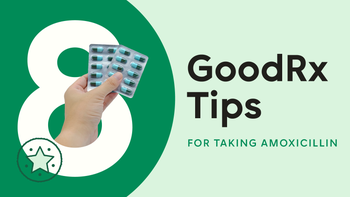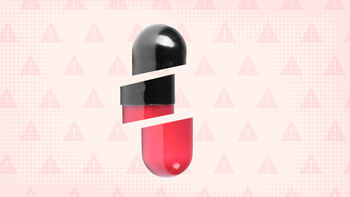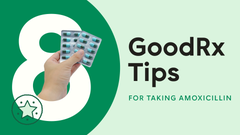
amoxicillin
Amoxicillin (Amoxil) is a penicillin antibiotic that's used to treat a wide variety of bacterial infections, such as sinus infections, ear infections, strep throat, and urinary tract infections (UTIs). It's available as oral pills, a chewable tablet, and an oral liquid. Amoxicillin (Amoxil) is well-tolerated, but possible side effects include diarrhea, vomiting, and rash.

Get your GoodRx coupon

What is Amoxicillin (Amoxil)?
What is Amoxicillin (Amoxil) used for?
Upper respiratory tract infections (ear, nose, and throat infections)
Lower respiratory tract infections (e.g., pneumonia, bronchitis)
Skin infections (e.g., cellulitis)
Helicobacter pylori infection (adults only)
How Amoxicillin (Amoxil) works
Amoxicillin (Amoxil) is a type of penicillin antibiotic. It kills bacteria by preventing them from making an additional covering around themselves for protection.
Drug Facts
More on Amoxicillin (Amoxil) essentials

What are the side effects of Amoxicillin (Amoxil)?
Common Side Effects
- Diarrhea
- Nausea
- Vomiting
- Rash
Other Side Effects
- Headache
- Taste changes
Serious Side Effects
- Serious allergic and skin reactions: hives, rash, blisters, skin reddening, blisters, swelling of the lips or tongue, difficulty breathing
- Infectious (C. difficile-related) diarrhea: rapid heart rate, foul-smelling diarrhea, fever, nausea, frequent bowel movements (even up to 15 times per day)
Source: DailyMed
More on Amoxicillin (Amoxil) side effects
The following side effects have also been reported
Along with its needed effects, a medicine may cause some unwanted effects. Although not all of these side effects may occur, if they do occur they may need medical attention.
Check with your doctor immediately if any of the following side effects occur:
Incidence not known
Abdominal or stomach cramps or tenderness
back, leg, or stomach pains
black, tarry stools
bleeding gums
blistering, peeling, or loosening of the skin
blood in the urine
bloody nose
chills
clay-colored stools
dark urine
diarrhea, watery and severe, which may also be bloody
difficulty with breathing
difficulty with swallowing
dizziness
fast heartbeat
feeling of discomfort
general body swelling
headache
heavier menstrual periods
hives or welts
increased thirst
inflammation of the joints
joint or muscle pain
loss of appetite
muscle aches
nausea or vomiting
nosebleeds
pain in the lower back
pain or burning while urinating
painful or difficult urination
pale skin
pinpoint red spots on the skin
puffiness or swelling of the eyelids or around the eyes, face, lips, or tongue
rash
red, irritated eyes
redness, soreness, or itching skin
shortness of breath
sores, ulcers, or white spots in the mouth or on the lips
sores, welting, or blisters
sudden decrease in the amount of urine
swollen, lymph glands
tenderness
tightness in the chest
unpleasant breath odor
unusual bleeding or bruising
unusual tiredness or weakness
unusual weight loss
vomiting of blood
watery or bloody diarrhea
yellow eyes or skin
Some side effects may occur that usually do not need medical attention. These side effects may go away during treatment as your body adjusts to the medicine. Also, your health care professional may be able to tell you about ways to prevent or reduce some of these side effects. Check with your health care professional if any of the following side effects continue or are bothersome or if you have any questions about them:
Less common
Bad, unusual, or unpleasant (after) taste
change in taste
Incidence not known
Agitation
black, hairy tongue
changes in behavior
confusion
convulsions
discoloration of the tooth (brown, yellow, or gray staining)
dizziness
trouble with sleeping
unable to sleep
white patches in the mouth or throat or on the tongue
white patches with diaper rash
Other side effects not listed may also occur in some patients. If you notice any other effects, check with your healthcare professional.
Call your doctor for medical advice about side effects. You may report side effects to the FDA at 1-800-FDA-1088.

Pros and cons of Amoxicillin (Amoxil)

Pros
Works well to treat many different bacterial infections
Can use for adults and children
Available in many forms (e.g., oral tablet, chewable tablet, capsule, liquid)
Liquid form comes in many different flavors to make it taste better

Cons
Might need to take up to three times per day
Can cause stomach side effects like nausea, vomiting, and diarrhea
Not the best option if you have severe kidney problems
Might not be able to take this medication if you've had a severe allergy to penicillin

Pharmacist tips for Amoxicillin (Amoxil)

Take amoxicillin (Amoxil) exactly as prescribed. Make sure to finish your treatment course, even if you're feeling better. Stopping the medication earlier than prescribed can make your infection come back and become harder to treat.
Swallow the amoxicillin (Amoxil) oral tablets and capsules whole. If you're having trouble swallowing them, ask your provider about switching you to the chewable tablets or suspension (liquid). If you have the chewable tablets, chew them first before swallowing; don't swallow them whole.
You can take amoxicillin (Amoxil) with or without food. But nausea, vomiting, and diarrhea are common side effects, so taking it with food can help lessen or prevent these side effects.
Some people notice changes in taste after starting amoxicillin (Amoxil). This side effect isn't harmful and should go away after you finish treatment.
Avoid drinking alcohol while taking amoxicillin (Amoxil) because it could raise your risk for stomach side effects (e.g., nausea, vomiting, diarrhea). Drinking alcohol can also make it harder for you to recover from your infection since alcohol can weaken your immune system.
Ask your provider whether it's safe and appropriate for you to take a probiotic to help lessen the risk of a rare, but more serious form of diarrhea caused by a Clostridium difficile (C. diff) bacterial infection. If your provider says you can, make sure to separate the probiotic from amoxicillin (Amoxil) by at least 2 hours to prevent the antibiotic from killing the "good" bacteria in the probiotic.
Get medical help as soon as possible if you develop watery or bloody diarrhea, fever, fatigue, or stomach cramps anytime during treatment or after stopping amoxicillin (Amoxil). These could be signs of C. difficile-related diarrhea, which needs to be treated right away.
Make sure to tell your provider about all of the medications you're taking before and during treatment with amoxicillin (Amoxil). Amoxicillin (Amoxil) interacts with some medications, such as warfarin (Coumadin) and allopurinol (Zyloprim). Your provider can check for drug interactions and make sure your medications are safe for you to take together.
More tips for amoxicillin (Amoxil) oral suspension:
Make sure you know which strength of the amoxicillin (Amoxil) oral suspension you have to avoid giving the wrong dose. There are three different strengths available.
Shake the bottle well before measuring out each dose. Make sure to only use a oral dosing syringe from the pharmacy to measure out your dose. Don't use household spoons because they aren't accurate and might cause you to take the wrong dose.
Store the amoxicillin (Amoxil) suspension at room temperature or in the refrigerator. After 14 days, throw away the bottle, even if there's still some medication left. Your pharmacist typically writes this date on the bottle to help remind you when to throw it away.
More on Amoxicillin (Amoxil) tips

Frequently asked questions about Amoxicillin (Amoxil)

How to save using GoodRx




What are the risks and warnings for Amoxicillin (Amoxil)?
Amoxicillin (Amoxil) can cause some serious health issues. This risk may be even higher for certain groups. If this worries you, talk to your doctor or pharmacist about other options.

Severe allergic and skin reactions
Risk factors: Allergy to penicillin | Currently have a mononucleosis infection
Severe allergic reactions to amoxicillin (Amoxil) are possible, including life-threatening reactions like facial swelling and anaphylaxis (e.g., closing of the throat). Let your provider know if you have an allergy to antibiotics. If you notice hives, rash, red skin, swelling of the lips or tongue, or difficulty breathing after taking amoxicillin (Amoxil), get medical help right away.
Additionally, although rare, amoxicillin (Amoxil) can cause serious skin reactions, such as Stevens-Johnson syndrome (SJS) and Drug Reaction with Eosinophilia and Systemic Symptoms (DRESS) syndrome. Amoxicillin (Amoxil) isn't recommended if you currently have a mononucleosis infection because a high number of people with this type of infection developed a skin rash when they took amoxicillin. Stop using amoxicillin (Amoxil) and get medical attention right away if you notice changes in your skin, such as rash, blisters, skin reddening, or skin peeling.

Diarrhea from Clostridioides difficile infection
Antibiotics, including amoxicillin (Amoxil), raise your risk of getting infected with a bacteria called Clostridioides difficile (C. diff). This infection can cause diarrhea that can sometimes be life-threatening. Antibiotics change the amount of normal bacteria in your stomach and intestines. This can cause C. diff to overgrow in your gut and lead to an infection. This type of infectious diarrhea is different than the diarrhea you might get as a possible side effect of amoxicillin (Amoxil). C. diff-related diarrhea can cause rapid heart rate, foul-smelling diarrhea, fever, nausea, bloody stools, or frequent bowel movements (even up to 15 times per day). This is considered a medical emergency. If you experience any of these symptoms, get medical attention right away so you can be tested for C. diff infection and receive treatment.

Development of drug-resistant bacteria
Your provider will make sure that you're taking amoxicillin (Amoxil) for the appropriate infection and amount of time. Using amoxicillin (Amoxil) for any shorter or longer periods of time or taking the antibiotic for other illnesses can raise your risk for developing infections caused by drug-resistant bacteria. This raises your risk for severe and life-threatening infections that might be difficult to treat.

Amoxicillin (Amoxil) dosage forms

| Dosage | As low as |
|---|---|
| 80ml of 125mg/5ml | $3.56 for 1 bottle |
| 100ml of 125mg/5ml | $3.83 for 1 bottle |
| 150ml of 125mg/5ml | $4.49 for 1 bottle |
| 50ml of 200mg/5ml | $5.66 for 1 bottle |
| 75ml of 200mg/5ml | $8.13 for 2 bottles |
| 100ml of 200mg/5ml | $7.42 for 1 bottle |
| 80ml of 250mg/5ml | $5.52 for 1 bottle |
| 100ml of 250mg/5ml | $9.36 for 2 bottles |
| 150ml of 250mg/5ml | $8.16 for 1 bottle |
| 50ml of 400mg/5ml | $11.43 for 5 bottles |
| 75ml of 400mg/5ml | $9.25 for 2 bottles |
| 100ml of 400mg/5ml | $10.61 for 2 bottles |
Typical dosing for Amoxicillin (Amoxil)
The dose and length of treatment depends on what type of infection you have, how serious it is, your weight, and whether you have kidney problems. Your provider will determine the right dose and length of treatment for you.
Amoxicillin (Amoxil) is available as tablets, capsules, and a liquid that are swallowed by mouth. This medication also comes as chewable tablets that are chewed before they're swallowed.
Mild or moderate upper respiratory tract infections, skin infections, and UTIs
Adults and children at least 3 months of age and weigh at least 88 lbs (40 kg): The typical dose is 500 mg by mouth every 12 hours or 250 mg every 8 hours.
Children at least 3 months of age and weigh less than 88 lbs (40 kg): The typical dose is 12.5 mg/kg of body weight by mouth every 12 hours or 6.7 mg/kg every 8 hours.
Children younger than 3 months of age: The typical dose is up to 15 mg/kg by mouth every 12 hours.
Lower respiratory tract and other severe infections
Adults and children at least 3 months of age and weigh at least 88 lbs (40 kg): The typical dose is 500 mg by mouth every 8 hours or 875 mg every 12 hours.
Children at least 3 months of age and weigh less than 88 lbs (40 kg): The typical dose is 13.3 mg/kg of body weight by mouth every 8 hours or 22.5 mg/kg every 12 hours.
Children younger than 3 months of age: The typical dose is up to 15 mg/kg by mouth every 12 hours.
H. pylori infection (adults only)
Triple therapy: The typical dose is 1 gram by mouth every 12 hours for 14 days. It's taken along with clarithromycin and lansoprazole (Prevacid).
Dual therapy: The typical dose is 1 gram by mouth every 8 hours for 14 days. It's taken along with lansoprazole (Prevacid).
More on Amoxicillin (Amoxil) dosage forms

Interactions between Amoxicillin (Amoxil) and other drugs
More on Amoxicillin (Amoxil) interactions
Using this medicine with any of the following medicines is usually not recommended, but may be required in some cases. If both medicines are prescribed together, your doctor may change the dose or how often you use one or both of the medicines.
- Chlortetracycline
- Cholera Vaccine, Live
- Demeclocycline
- Desogestrel
- Dienogest
- Doxycycline
- Drospirenone
- Eravacycline
- Estradiol
- Ethinyl Estradiol
- Ethynodiol
- Gestodene
- Levonorgestrel
- Lymecycline
- Meclocycline
- Mestranol
- Methacycline
- Methotrexate
- Minocycline
- Mycophenolate Mofetil
- Nomegestrol
- Norethindrone
- Norgestimate
- Norgestrel
- Omadacycline
- Oxytetracycline
- Rolitetracycline
- Sarecycline
- Sulfasalazine
- Tetracycline
- Tigecycline
- Venlafaxine
- Warfarin
Using this medicine with any of the following medicines may cause an increased risk of certain side effects, but using both drugs may be the best treatment for you. If both medicines are prescribed together, your doctor may change the dose or how often you use one or both of the medicines.
- Acenocoumarol
- Khat
- Probenecid

How much does Amoxicillin (Amoxil) cost?

Amoxicillin (Amoxil) contraindications
Severe allergy to other penicillins or beta-lactam antibiotics (e.g., cephalexin (Keflex))

What are alternatives to Amoxicillin (Amoxil)?
Upper respiratory tract infections (ear, nose, and throat infections)
Lower respiratory tract infections (e.g., pneumonia, bronchitis)
Skin infections (e.g., cellulitis)
Helicobacter pylori infection (adults only)
Skin infections
Bone infections
Urinary tract infections (UTIs)
Reproductive system infections

What is the latest news about Amoxicillin (Amoxil)?

Amoxicillin (Amoxil) images
Get savings updates for Amoxicillin (Amoxil)
Receive price alerts, news, and other messages from GoodRx about Amoxicillin (Amoxil) and other healthcare topics and relevant savings offers.By signing up, I agree to GoodRx's Terms and Privacy Policy, and to receive marketing messages from GoodRx.
References
Best studies we foundAudicana, M., et al. (1994). Allergic reactions to betalactams: Studies in a group of patients allergic to penicillin and evaluation of cross-reactivity with cephalosporin. Allergy.
Aung, T.Y. et al. (2016). Drugs Induced Nausea and Vomiting: an Overview. Journal of Pharmacy and Biological Sciences.
Centers for Disease Control and Prevention. (2022). Pharyngitis (strep throat).
Gupta, K., et al. (2011). International clinical practice guidelines for the treatment of acute uncomplicated cystitis and pyelonephritis in women: A 2010 update by the Infectious Diseases Society of America and the European Society for Microbiology and Infectious Diseases. Clinical Infectious Diseases.
Muanda, F. T., et al. (2017). Use of antibiotics during pregnancy and the risk of major congenital malformations: a population based cohort study. British Journal of Clinical Pharmacology.
Pandey, N., et al. (2023). Beta-lactam antibiotics. StatPearls.
Teva Pharmaceuticals USA, Inc. (2023). Amoxicillin tablet, film coated; amoxicillin powder, for suspension; amoxicillin tablet, chewable; amoxicillin capsule [package insert]. DailyMed.
Browse medications
View AllResearch prescriptions and over-the-counter medications from A to Z, compare drug prices, and start saving.



















